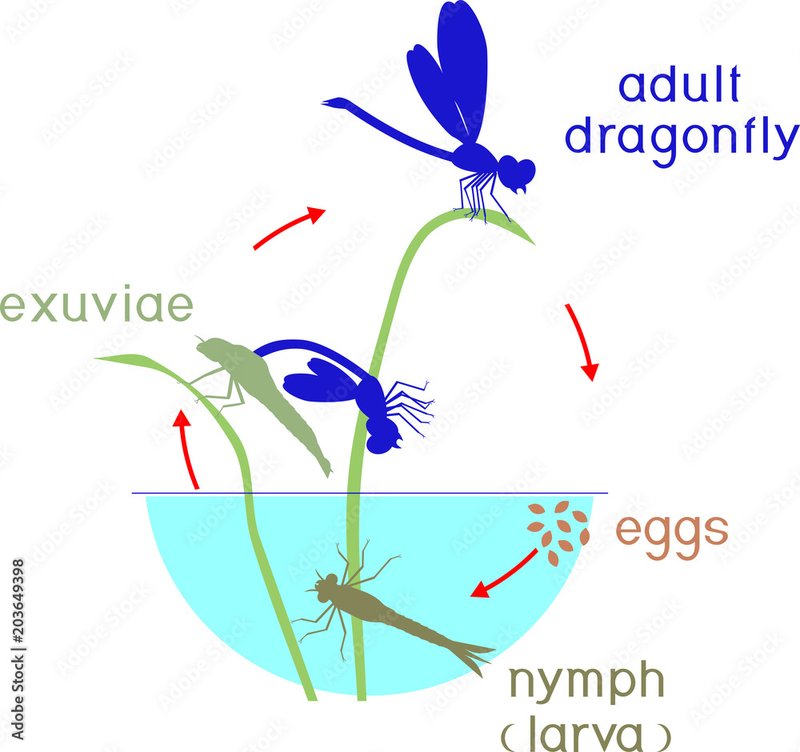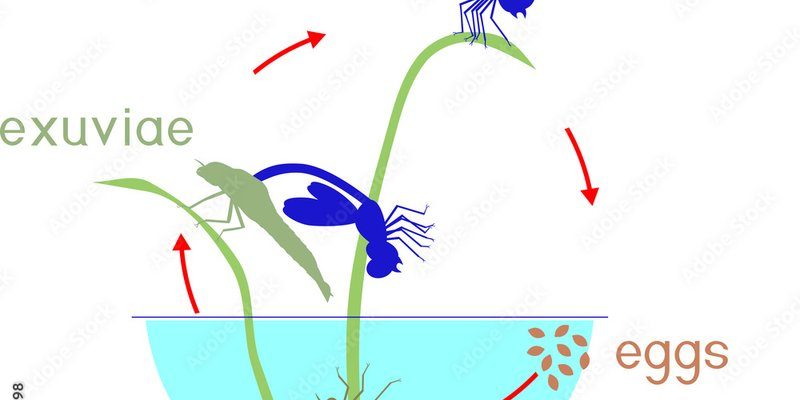
Dragonflies belong to the order Odonata, which means “toothed ones” in Greek. This refers to the serrated edges of their mouthparts, which help them snag prey. Their lifecycle is divided into several distinct stages: egg, nymph, and adult. Each stage has its own unique experiences and challenges, kind of like growing up, but in the world of insects. Let’s dive deeper into how a dragonfly transforms through each stage, unveiling the magic of nature along the way.
The Egg Stage: Where It All Begins
Dragonflies typically lay their eggs in or near water, often in small clusters or singly, depending on the species. The eggs are small, round, and sometimes even resemble tiny pearls nestled among reeds or floating on the water’s surface. You might be surprised to learn that some species attach their eggs to plants, while others simply drop them into the water!
Once laid, these eggs can take a few days to several weeks to hatch, depending on environmental factors like temperature and water quality. It’s like waiting for popcorn to pop. You know something exciting is happening inside, but you can’t see it just yet. Dragonfly eggs are sensitive, and various factors, such as pollution or predators, can affect their survival.
As the eggs develop, they undergo a transformation. Tiny, immature dragonflies, or nymphs, emerge from the eggs. They’re small but filled with potential. This stage is crucial, as around 50% of the eggs may not survive to hatch. Nature can be tough, but that’s just part of the story.
The Nymph Stage: An Underwater Adventure
Now that the nymph has emerged, it enters an entirely different world—water. This stage can last anywhere from a few months to several years, depending on the species and environmental conditions. Think of it as dragonfly boot camp. The nymphs are aquatic and have a unique appearance, featuring long, slender bodies and extendable jaws.
During this period, they grow and molt several times, shedding their skin to get bigger. It’s quite an astonishing sight! They can often be found lurking in the mud at the bottom of ponds or lakes, waiting to ambush their next meal. Nymphs are voracious eaters, consuming a diet that includes other insects, tadpoles, and even small fish. They use their specialized jaws to grasp prey, making them quite effective hunters even from a young age.
One fascinating fact is that nymphs can breathe through gills in their abdomen! They can also swim quickly by expelling water from their bodies, allowing them to escape predators. As they grow, they prepare for a big change, one that will take them from the water into the sky.
The Transformation: Preparing to Fly
When the nymph is ready to transition into adulthood, it climbs out of the water onto a sturdy surface—like a rock or a plant stem. This is where the real magic happens. The nymph’s skin splits open, and it begins to emerge into the world as a dragonfly. This transformation is known as exuviation.
At first, the newly emerged dragonfly is soft and vulnerable. Its wings are crumpled and wet, making it look quite different from the colorful creatures we commonly associate with the species. Over time, the wings will dry and expand, taking on their beautiful patterns and colors. This process can take from a few hours to several days, and during this time, the dragonfly is particularly vulnerable to predators.
Isn’t it amazing how much can change in just a few hours? This stage symbolizes the culmination of all the challenges the dragonfly has faced so far. Once its wings are fully developed and dried, it’s ready to take its first flight. It’s a moment filled with anticipation, much like a child’s first leap into the pool.
The Adult Stage: The Flying Wonder
Once the dragonfly takes to the air, it becomes a majestic predator, gliding gracefully above water, darting after prey, and even performing acrobatic maneuvers. Adult dragonflies are known for their incredible flight abilities; they can hover, fly backward, and even change direction mid-air. It’s like watching a tiny aerial acrobat!
In this stage, dragonflies primarily focus on feeding and mating. They consume a wide variety of insects, including mosquitoes, flies, and bees—making them beneficial allies in natural pest control. A single dragonfly can eat hundreds of insects in a day! Their massive compound eyes allow them to spot prey quickly, making them efficient hunters.
Adult dragonflies are also incredibly colorful, with hues ranging from brilliant blues to fiery reds. These colors are not just for show; they can also play a role in communication and mating displays. During courtship, males might perform intricate flying patterns to attract females. You might say it’s their way of showing off their best moves.
The Importance of Dragonflies in Ecosystems
Dragonflies may be small, but their role in the ecosystem is significant. As both predators and prey, they help maintain the balance of various populations. This makes them essential players in the food web. By keeping down the numbers of pesky insects, dragonflies can help reduce the spread of diseases caused by those insects.
Additionally, dragonflies are indicators of environmental health. Their presence signals clean, healthy water, while a decline in their populations can indicate issues such as pollution or habitat destruction. This can guide conservation efforts and environmental monitoring. So, when you see a dragonfly hovering nearby, it’s not just a pretty sight; it’s a clue that the ecosystem is thriving.
Unfortunately, dragonflies face threats from habitat loss, climate change, and pollution. It’s essential for us to protect the natural habitats where they thrive, ensuring that these stunning creatures can continue their lifecycle. After all, preserving their world means we’re preserving a little bit of magic in nature.
The Seasonal Life Cycle: A Year in the Life
The lifecycle of dragonflies can be quite seasonal. Depending on the species, adult dragonflies typically emerge between late spring and early fall. This timing often coincides with warmer temperatures and abundant food sources. As seasons change, dragonflies adapt to the environment, going through their lifecycle in sync with nature.
In cooler climates, some dragonfly species may enter a stage of dormancy during the winter months. Nymphs can hibernate at the bottom of ponds or lakes, waiting for warmer weather to continue their journey. This seasonal adaptation is crucial for their survival, as it allows them to persist through harsh conditions.
Understanding this seasonal aspect of dragonflies gives us insight into their resilience and remarkable ability to thrive despite environmental changes. It also highlights the importance of local ecosystems in supporting diverse life cycles, reminding us of the interconnectedness of all living beings.
The lifecycle of a dragonfly—from egg to adult—is a complex, beautiful process that showcases the wonders of nature. Each stage brings its challenges and transformations, ultimately resulting in the stunning adults that dance in the air. As we explore these magical creatures, we gain a greater appreciation for their role in our ecosystems and the delicate balance of life.
So, the next time you see a dragonfly flitting around a pond, take a moment to appreciate the incredible journey it has taken to get there. From the humble egg hidden in the reeds to the graceful adult soaring through the sky, the dragonfly’s story is one of resilience, adaptation, and beauty. Let’s make sure to cherish and protect their habitats, ensuring that future generations can enjoy witnessing the magic of dragonflies, just as we do today.

